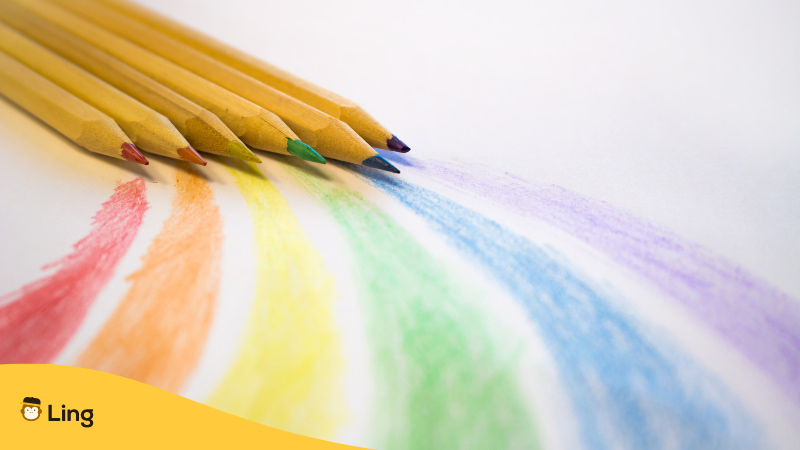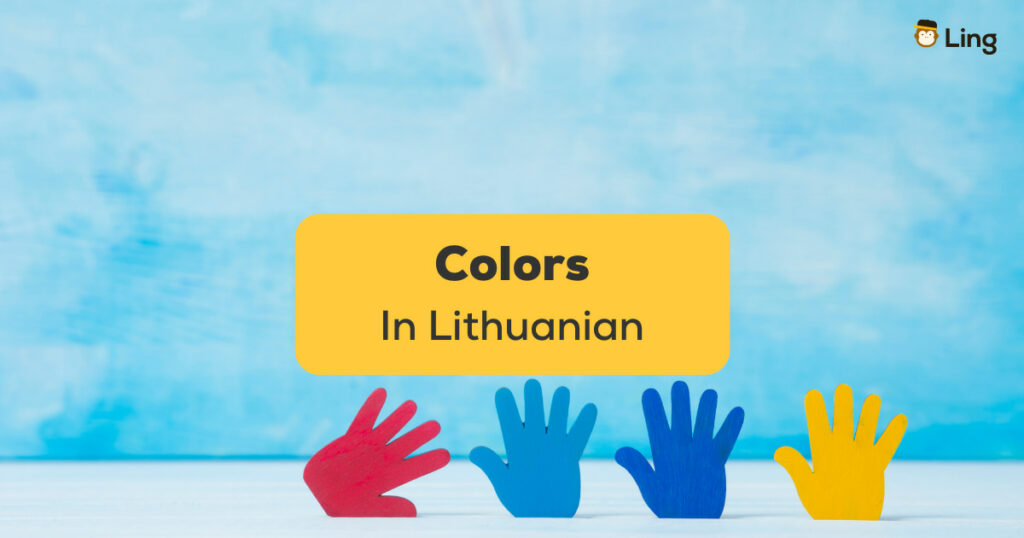Learning the names of colors in Lithuanian is an excellent way to increase your knowledge of Lithuanian vocabulary, especially if you are new to Lithuanian.
The world is a colorful place, and if you have already mastered colors from other languages, you can try using colors as adjectives to enrich your sentences to a new level. Learning Lithuanian is easy when you can use vocabulary related to what your interests are. So let’s dive in deep about the colors in Lithuanians’ eyes.
Colors In Lithuanian Language
In Lithuanian, the word ‘color’ can translate into a word with different versions, based on the singular/plural and other factors. For example, we have spalva which means color. Spalvas means colors, more than one color. There are also spalvotas that translate to colorful.
Below is a list of the colors. More can be found at the end of the post.
| English | Lithuanian |
|---|---|
| Blue | mėlyna |
| Yellow | geltona |
| Orange | oranžinė / morkinė |
| Red | raudona |
| Pink | rožinė |
| Brown | ruda |
| Violet purple | violetinė |
| Green | žalia |
| White | balta |
| Black | juoda |
Now that you’ve practiced the primary and secondary colors in Lithuanian, you need consistent practice to memorize these words. With an amazing language-learning app like Ling, you’ll find yourself creating your own learning patterns. Don’t know where to start? Download it now on the Play Store or App Store!

Colors In Lithuanian: Feminine Vs. Masculine
Declension is the changing of the form, generally to express its syntactic function in the sentence. One of the examples can be seen above when I describe the different forms of spalva.
The nouns in Lithuanian can be divided based on gender, masculine and feminine. Originally, the noun spalvos is feminine in the first place, which is also the reason most of the words end with the feminine vowel ‘a’.
To use the color words as adjectives, one needs to pinpoint if the noun used is masculine or not and then change the colors accordingly. Here are some examples:
The noun ‘grass’ is feminine, so if you say ‘the grass is green,’ it would be ‘žolė yra žalia.’ If you’re going to say “that is a green leaf,” you would need to change žalia into žalias:
Tai žalias lapas.
That is a green leaf.
Žolė yra žalia.
The Grass is green.
Other examples:
- Green grass (f) = žalia žolė
- Green cucumber (m) = žalias agurkas
- Yellow flower (f) = Geltona gėlė
- Yellow field (m) = Geltonas laukas
- White table (f) = balta lentelė
- White cloth (m)= baltas audinys
- Gray sofa (f) = pilka sofa
- Gray cloud (m) = pilkas debesis
- Red book (f) = raudona knyga
- Red car (m) = raudonas automobilis
- Black cat (f) = juoda katė
- Black sky (m) = Juodas dangus
- Brown blanket (f) = ruda antklodė
- Brown belt (m) = rudas diržas
As you have noticed, mostly, to change the colors to masculine, in most cases, you have to add a letter ‘s’ at the end of the word. This is pretty simple, and you can do this!
Aside from that, if the Lithuanian noun is in plural form, declensions happen as well.
For example:
- Blue flower (f)= mėlynos gėlės
- Red books (f) = raudonos knygos
- Yellow cars (m) = geltoni automobiliai
- Grey clouds (m) = pilki debesys
As observed, for feminine plural, the end of the word should change into ‘os’; while for masculine plural colors, it should change into ‘i’.
Colors In Lithuanian: Pronunciation
Next, how to pronounce them? The pronunciation does not work the same way as in English. Here are some simplified ways of pronouncing these words.
As you can see, they are all feminine adjectives since they end in the vowel ‘a’, except several ones, as I mentioned in the previous section. And if you need to pair it with a masculine noun, you must add ‘s’ to the word. Feel free to practice it out loud!
- Juoda (YWOh-dah)
- Balta (BAHL-tah)
- Pilka (PIHL-kah)
- Raudona (row-DAW-nah)
- Mėlyna (MEHH-lee-nah)
- Geltona (ghehl-TAW-nah)
- Žalia (ZHAH-lyah)
- Oranžinė (aw-RAHN-zhih-nehh)
- Violetinė (vyaw-LEh-tih-nehh)
- Ruda (roo-DAH)
- Rausva (ROWS-vah)
If you are not sure how to pronounce them, you can focus on the stress of a certain syllable. For example, in the shorter adjectives, like ruda, juoda, pilka, and balta, the stress is usually on the ‘ah’ vowel at the end. Meanwhile, longer ones, like geltona, mėlyna, violetinė have stress on the first or second vowel (you can refer to the above and stress on the capitalized syllable).

Other Colors In Lithuanian:
| English | Lithuanian | Notes |
|---|---|---|
| Blue | mėlyna | |
| Light blue | žydra | |
| Azure | azurinė | |
| Yellow | geltona | |
| Orange | oranžinė / morkinė | morkinė is referring more to the hue of carrot since it comes from the word ‘carrot’. |
| Red | raudona | |
| Cherry red | vyšninė | Referring more to the red of cherry comes from the word ‘cherry’ which is vyšnia |
| Pink | rožinė | it is the color of roses because it was derived from rožė which means ‘rose‘. |
| Brown | ruda | |
| Purple | violetinė | |
| Green | žalia | |
| Green | Salotinė | Referring to the color of salad because it comes from the word ‘salad’ or ‘lettuce’ which is Salatos |
| White | balta | |
| Black | juoda | |
| Gray | pilka | |
| Silver | sidabro | |
| Gold | Aukso |
Other Accompanying Vocabulary
| English | Lithuanian |
|---|---|
| a color | spalva |
| colors | spalvas |
| Colorful | spalvotas |
| Colored | spalvos |
| Colorless | bespalivis |
| -ish (for lighter color) | -svas |
| Reddish | rausvas |
| Blueish | melsvas |
| Greenish | žalsvas |
| Yellowish | gelsvas |
| Whiteish | balsvas |
| Blackish | juosvas |
| Brownish (hazel) | rusvas |
| grayish | pilkšvas |
| Colorful | spalvotas |
| Colorful | spalvingas |
| Colorful language | spalvinga kalba |
| Paint (noun) | tapyti |
| Rainbow | vaivorykštė |
| Watercolor | Akvarelė |
| Crayon | Pieštuku |
Want To Learn More Lithuanian?
Vocabulary is the basis of a language. I hope you take this chance to add more to your collection. It would be easier for you to memorize these colors if you associate them with images. If you want to learn more Lithuanian vocabulary, we have some on transportation, love words, house-related, and many more.
But if you want to learn more about the Lithuanian language, you can give the Ling app a try. This app can help you with everything you need to know about a language – alphabets, sentence structure, basic phrases and expressions, greetings, pronouns, grammar, pronunciation, and so much more. This way you can make your language more spalvingas and impress people when you arrive in Lithuania.














